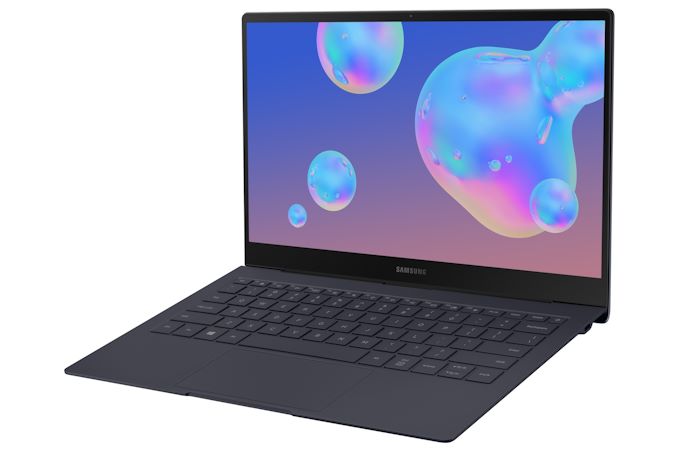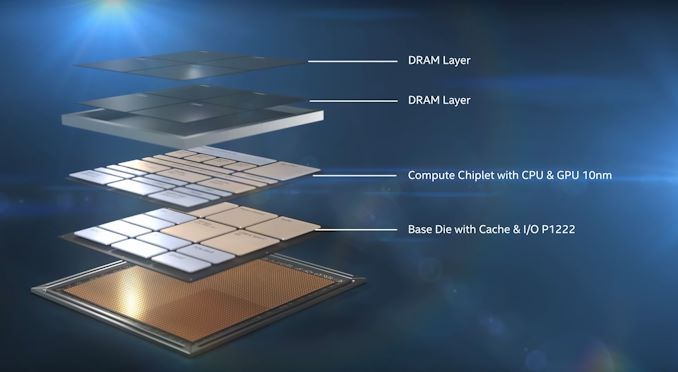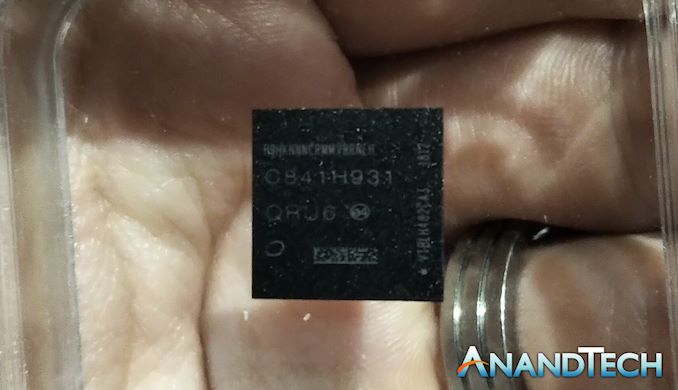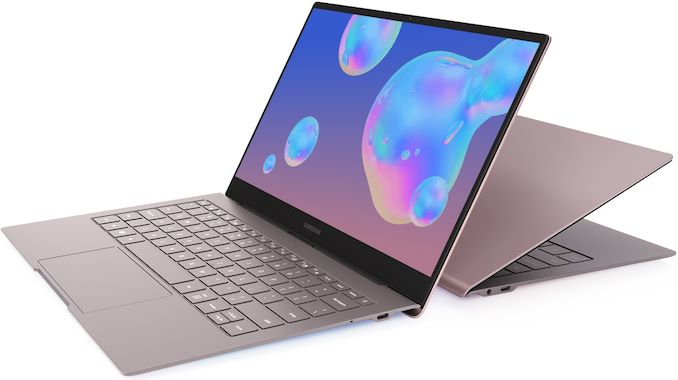Samsung Unveils Intel-based Galaxy Book S: Intel’s Lakefield Inbound
by Ryan Smith on May 29, 2020 11:30 AM EST
Samsung this morning is taking the wraps off of the long-awaited Intel (x86) version of the company’s popular ultraportable, always-connected laptop, the Galaxy Book S. First teased by Samsung late last year, the Intel-based version of the laptop is set to join their existing Qualcomm 8cx-based model, swapping out the Arm SoC for Intel’s latest foray into ultra-mobile processors, Lakefield. The Intel Galaxy Book S will be the first device to ship with Lakefield, putting the new processor to the test in seeing if Intel can match the kind of all-day battery life that the existing Galaxy Book S is known for.
As a quick refresher, for the last couple of years now we’ve been reporting on Intel’s forthcoming die stacked CPU, codenamed Lakefield. Officially called the “Intel Core processor with Intel Hybrid Technology”, Lakefield is a rather audacious chip for a company that’s been criticized for moving too slowly, as it integrates a number of first-time technologies for Intel as they look to deliver a cutting-edge x86-based chip that’s properly suited for the ultra-mobile market.
In terms of architecture, Lakefield is the first hybrid CPU from Intel, combining both the company’s Atom (Tremont) and Core (Sunny Cove) CPU cores on to a single die. This sort of big-little strategy has been a big part of Arm’s success in mobile devices, by offering separate high-performance and low-power cores to maximize efficiency without giving up on higher performance as well, and by incorporating it for their own designs it will mark a significant departure from Intel’s existing Atom-only offerings. At the same time, Lakefield is designed to be vastly more efficient than those earlier Atoms, with Intel aiming to get idle power consumption down to a couple of milliwatts, necessary to allow for devices that can be always-connected/always-on, and to breach the ultra-mobile market largely dominated by Qualcomm.
The other novel aspect of Lakefield is its construction. The chip is based on Intel’s Foveros technology, which is the company’s take on 3D die stacking using TSVs. In the case of Lakefield, Intel has split up the chip into essentially 3 levels, stacked upon each other: a 14nm-built base I/O die that has features like USB an audio, a 10nm-built compute chiplet that has the CPU and GPU cores, and finally a DRAM layer connected using more traditional Package-on-Package technology. This strategy not only lets Intel split up the manufacturing of the chip across multiple process nodes – using cutting-edge 10nm for the compute while using a highly-tuned 14nm node for the base die – but it minimizes the overall footprint of the chip. Lakefield has a footprint of just 12mm x 12mm (and 1mm tall), making the package smaller than a dime.
This chip, in turn, will be making its debut in Samsung’s Galaxy Book S family. Samsung has been shipping a Qualcomm 8cx version of this laptop since earlier this year, using Qualcomm’s ultra-mobile chip to drive the always-connected laptop. Qualcomm has been a major proponent of always-on laptops, leveraging their years of expertise in modems and low-power operation in general from smartphones to apply it to laptops, and with a rated battery life of up to 25 hours, the current Qualcomm-based version of the Galaxy Book S has certainly lived up to those goals.
| Samsung Galaxy Book S Family | ||
| Galaxy Book S (Intel) | Galaxy Book S (Qualcomm) | |
| CPU | Intel Core with Hybrid Technology 1x Sunny Cove (Core) 4x Tremont (Atom) |
Qualcomm Snapdragon 8cx 4x Kryo 495 Gold @ 2.84 GHz 4x Kryo 495 Silver @ 1.8 GHz |
| GPU | Intel UHD Graphics | Adreno 680 |
| Display | 13.3 Inch, 1920×1080 Full HD Touchscreen |
|
| Memory | 8 GB LPDDR4X | |
| Storage | 256/512 GB eUFS + microSD Card Slot |
256/512 GB + microSD Card Slot |
| Networking | Wi-Fi 6 (802.11ax) BT 5.0 |
Wi-Fi 5 (802.11ac) BT 5.0 |
| Modem | Discrete LTE Cat 16 |
Integrated Qualcomm X20 LTE Cat 18 |
| Battery | 42 Wh | |
| Ports | 2 x USB-C 1 x 3.5 mm (phono/mic) |
|
| Dimensions (WxDxH) | 305.2 x 203.2 x 11.8 mm | |
| Weight (Approx) | 950g | 960g |
| Price (USD) | N/A | Starts at $999 |
So with Lakefield intended to go head-to-head with the likes of Qualcomm’s 8cx, there’s no better place for Intel to start than the Galaxy Book S. But this also means that they’ll have a tough fight right out of the gate, as they’ll be going up against one of the better Arm-powered laptops on the market.
Meanwhile, taking a look at the specifications, the Intel-based version of the Galaxy Book S is a spitting image of the Qualcomm version. Samsung appears to be using the same chassis here, so the 13.3-inch laptop retains the same dimensions as the current model, as well as the same two USB-C ports. The battery capacities are identical as well at 42 Wh, and I expect that the Intel model is also using the same 1080p LCD. Curiously though, the Intel model does end up being ever so lighter than the Qualcomm model – Samsung puts the former at 950g, 10g lighter than the 960g Qualcomm model.
As for RAM and storage, because RAM is part of the Lakefield package, Samsung is only offering a single 8GB configuration here. Unfortunately Samsung’s spec sheet doesn’t list memory frequencies, so we’ll have to wait and see what Intel has Lakefield’s memory clocked at. Meanwhile Samsung provides the storage, using 256GB or 512GB of their eUFS flash memory. To my knowledge this is the first x86 laptop to ship with eUFS, reflecting the mobile roots of the devices Intel is targeting with Lakefield. Further storage expansion is then available through a microSD card slot.
One specification that’s notably missing from Samsung’s announcement today is the expected battery life of the Intel-based model, and this is perhaps going to be the most interesting aspect of Lakefield. Intel has worked very hard to get their idle power consumption down to be able to match what Qualcomm has achieved with the 8cx, with the company claiming that Lakefield draws just 2mW at idle. At the same time, however, Lakefield lacks an integrated modem, and as a result Samsung is relying on an unknown Cat 16 external modem here. So in the battle of the Galaxy Books, Qualcomm will have the advantage in regards to requiring fewer chips.
As for other wireless connectivity, the new Intel model will ship with a 2x2 Wi-Fi 6 radio, giving it an edge there over the Qualcomm model with Wi-Fi 5. And both models ship with Bluetooth 5.0 support.
Rounding out the package, the Intel-based Galaxy Book S has a 720p webcam, a built-in microphone as well as Dolby Atmos-badged stereo speakers co-designed with AKG. The laptop also has a Windows Hello-compatible fingerprint reader.
Wrapping things up, with Samsung finally unveiling the full specifications of the Intel-based Galaxy Book S, this is a strong sign that the laptop and Intel’s Lakefield processors should be available soon. While Intel has yet to formally launch the processors, Lakefield’s been expected as a mid-2020 part for some time now, so given this, Lakefield’s launch should be imminent. The precise details of which Samsung seems to be leaving to Intel; at least for the moment, Samsung is not announcing specific availability dates or pricing. Though if it’s at parity with the Qualcomm-based model, then expect the Intel-based Galaxy Book S to start at $999.
Source: Samsung














49 Comments
View All Comments
nandnandnand - Friday, May 29, 2020 - link
Lakefield looks great but is late (teased in January 2019). I'll check out AMD's "Van Gogh" instead.https://www.notebookcheck.net/Report-AMD-s-upcomin...
yeeeeman - Friday, May 29, 2020 - link
Man, some people are delirious. Spare me with AMD, we're talking about an Intel product here.Desierz - Friday, May 29, 2020 - link
AMD doesn't have anything similar afaik. This is Big.little + integrated RAM on the die. Presumably this will save power.Wilco1 - Friday, May 29, 2020 - link
The DRAM is a separate die and uses the same PoP stacking mobile SoCs have been doing for many years: https://fuse.wikichip.org/news/3417/a-look-at-inte...Desierz - Friday, May 29, 2020 - link
Aha. I guess I was blinded by the cool "Foveros technology" name. It sounded like they had something new and exciting. Turns out it's just a name for something that's been done for years by others already. Well, I hope it lives up to the hype, anyway.lmcd - Friday, May 29, 2020 - link
The lower stack is interesting tech even if the DRAM stacking is not new.Santoval - Friday, May 29, 2020 - link
Not yet they don't. However the link above refers to AMD's *future* APUs. AMD are also going to switch to 3D stacking.Desierz - Friday, May 29, 2020 - link
Sure. The industry talks about it as way to further Moore's law. So I expect to see it become a widespread technology in CPUs and other ICs.lmcd - Friday, May 29, 2020 - link
Yea but AMD dropped their cat cores out of monetary need a while ago, even though a cat core would be perfect for this.nandnandnand - Friday, May 29, 2020 - link
I'll buy the Intel product. For $100.